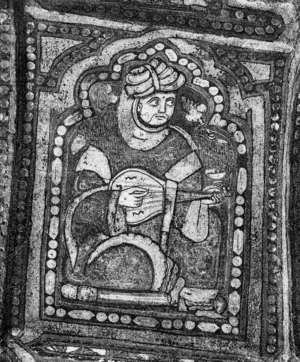Ibn Hamdis facts for kids
Ibn Hamdis (born around 1056, died around 1133) was a famous Sicilian Arab poet. He wrote many poems. His full name was Ibn Ḥamdīs al-ʾAzdī al-Ṣīqillī.
Contents
Early Life and Education
Ibn Hamdis was born in Syracuse, a city in southeastern Sicily, around the year 1056. We don't know much about his childhood. What we do know comes from hints in his poems.
His poems show he was very skilled in Arabic poetry. He also had a deep understanding of language. This suggests he had a very good education. It's likely Ibn Hamdis grew up in a wealthy family. They might have owned land in the Val di Noto. His family probably settled in Sicily after the Muslim conquest of Sicily in the 800s.
Changes in Sicily
The good times for Muslims in Sicily did not last. In the late 1000s, Muslim Sicily became unstable. Different leaders fought among themselves for many years. The Kalbid court in Palermo had lost its power. Warlords had divided the island into three parts.
The Normans were a group from northern Europe. They took advantage of this weakness. They slowly started to conquer the island. Ibn Hamdis was about five years old when the Norman armies arrived. They landed in Messina and moved towards Palermo. A Sicilian Arab warlord named Ibn al-Thumna helped them.
When Palermo fell in 1072, the hope for Muslim rule in Sicily faded. Many Muslim Sicilians began to leave the island. This movement of people is called a diaspora.
Travels and New Homes
Ibn Hamdis, like many others, sailed to North Africa. He went with his wife and sons to Sfax to find relatives. Not long after, he traveled again. This time he went to al-Andalus, which is modern-day Spain. He was drawn by the good reputation of al-Mu'tamid ibn Abbad. Al-Mu'tamid was known for supporting artists and poets.
Ibn Hamdis went to Seville and met al-Mu'tamid. The young poet joined al-Mu'tamid's group of poets who wrote praise poems. Ibn Hamdis lived in al-Andalus for thirteen years. He saw many important political events there. Christian armies were attacking from the north. Also, the Almoravid empire was growing and threatening to take over.
In 1091, Ibn Hamdis saw his friend al-Mu'tamid arrested. He was then sent to North Africa. This happened in Seville, and the people were very upset. In the same year, the Norman conquest of Sicily was completed. The Almoravids took over al-Andalus. They were not very fond of poetry and fancy city life. They thought these things were not religious enough.
Ibn Hamdis decided to leave again. He had a dangerous sea journey. His boat was shipwrecked, and his beloved slave-girl, Jawhara, drowned. He wrote some of his saddest poems about her. The poet then settled in North Africa again. He found new supporters at the Zirid court in Mahdiya, which is in modern-day Tunisia.
There, he wrote poems praising the Zirid rulers. These included Tamim ibn al-Mu'izz, Yahya ibn Tamim, Ali ibn Yahya, and al-Hasan ibn Ali. He also praised al-Mansur ibn al-Nasir of the Hammadid dynasty in Bijaya, Algeria. It's not clear exactly how he traveled between these courts.
According to a historical book, Ibn Hamdis died in 1132 or 1133. He was 77 years old. He may have died in Majorca, where he wrote two praise poems for the island's ruler. However, many of his poems talk about being old. This suggests he might have been over 80 years old when he died. He might have been buried near his friend Ibn al-Labbana and his countryman Abu al-Arab.
His Writings
The Sicilian scholar Ibn Zafar (who died around 1169) said that Ibn Hamdis wrote his own dīwān. A dīwān is a collection of poems. Two copies of his dīwān still exist today. One copy is kept at the Vatican Library in Rome. The other is at the Asiatic Museum in Saint Petersburg.
Other poems by Ibn Hamdis can be found in another book. This book is called Dhakhīra fī Maḥāsin ʾAhl al-Jazīra by Ibn Bassam. Some of these poems are the same as those in his dīwān. Others are unique, and some have different versions.
Ibn Hamdis's Influence Today
For much of the 1900s, people didn't talk much about Ibn Hamdis. But in 1969, Leonardo Sciascia mentioned him in an article. This article was about Sicily and its culture.
Since the 1990s, people in Italy, especially in Sicily, have started to appreciate Ibn Hamdis's work more. They also appreciate Arab culture in Sicily in general. This renewed interest has inspired Italian poets and musicians.
The Sicilian poet Sebastiano Burgaretta was clearly influenced by Ibn Hamdis. Burgaretta even wrote a powerful poem in Sicilian dedicated to the great Arab-Sicilian poet. This poem won the Vann'antò Saitta Prize.
In 2007, events called "Zagara and Rais" were held in Sicily. These events honored Arab poets from Sicily. They were supported by the Sicilian Region.
The music group Milagro Acoustic has made three albums about the poetry of Arab poets from Sicily. They especially focus on Ibn Hamdis. Their albums are: Arab Poets of Sicily (2005), SIQILIAH land of Islam - Arab travelers and poets of Sicily (2007), and ARAB SICILY (2013).
In 2008, the Catania singer Etta Scollo created a show. It was called Il Fiore Splendente (The Shining Flower). The show was based on the poems of Ibn Hamdis and other Arab poets of Sicily. It was very popular, even in Germany.
In 2011, the Sicilian musician Franco Battiato set some of Ibn Hamdis's works to music. This project was called Diwan: The Essence of the Real. It celebrated Sicily's rich Islamic cultural history.
See also
 In Spanish: Ibn Hamdís para niños
In Spanish: Ibn Hamdís para niños


